Word Heist: A Theros Beyond Death Caper
I swear, I wasn't looking for a score. I was walking the straight and narrow. Sure, sometimes I thought about the old life. It was exciting, you know? The edge of danger, the thrill of the chase, the risk of falling off the tightrope. But I had a family now. I couldn't afford to get put away. Keep my head down, work a legit job, live a quiet life. It was a pocket-sized paradise.
It was nice.
It couldn't last.
INTRODUCING THE STATISTICIAN: YONI SKOLNIK
Yoni's got a head for numbers and a heart for taking chances. He always knows the odds. He keeps his head on a swivel, always looking around for opportunities. And he stumbled on a big one. Deep into the set design phase of Theros Beyond Death, Yoni emailed this chart to a trusted cabal of designers.

If it's red, it's hot.
It's common practice for Magic designers to track average word count on commons and uncommons. It's a very basic shorthand measure for complexity. If the commons, as a whole, have very few words, the set is probably not doing a lot of interesting, dynamic things. If the commons, as a whole, have a ton of words, the set is probably ponderous and hard to process, either filled with so many decision points that the games are tedious or a bunch of marginal abilities whose impacts aren't worth the ink it takes to print them. We don't have a hard-and-fast rule about this sort of thing, but we do have guidelines that lay out a happy range that most sets try to stay inside.
But tracking average word count on rares and mythic rares? That's wild. There's only one per booster pack, so having a wordy card in that slot won't move the average word count of that booster too much. But if a preponderance of a set's rares and mythic rares are walls of text in the minimum font size, that's a red flag. If the most exciting cards are, collectively, dense and tedious, they're not the most exciting cards, are they?
Yoni gave us a prime candidate for a takedown. But we needed more analysis. We needed to case the joint.
INTRODUCING THE WORDSMITH: GREGG LUBEN
Gregg was the Theros Beyond Death editor. He took the lay of the land, crunched the numbers, and laid it all out for us.
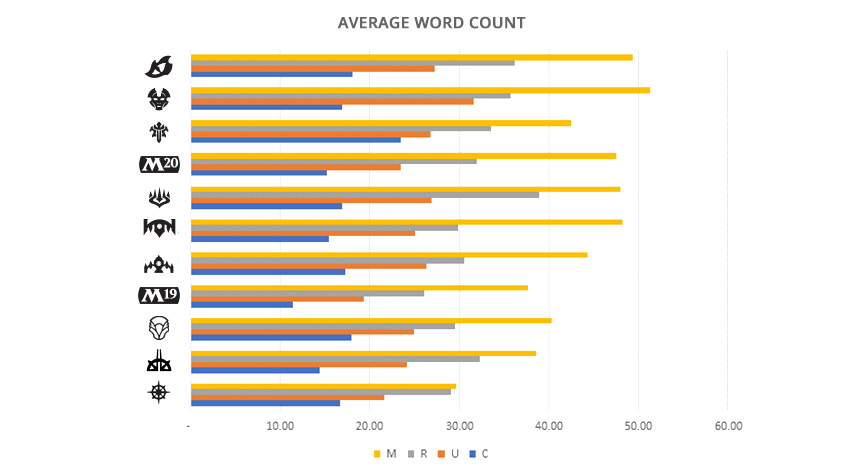
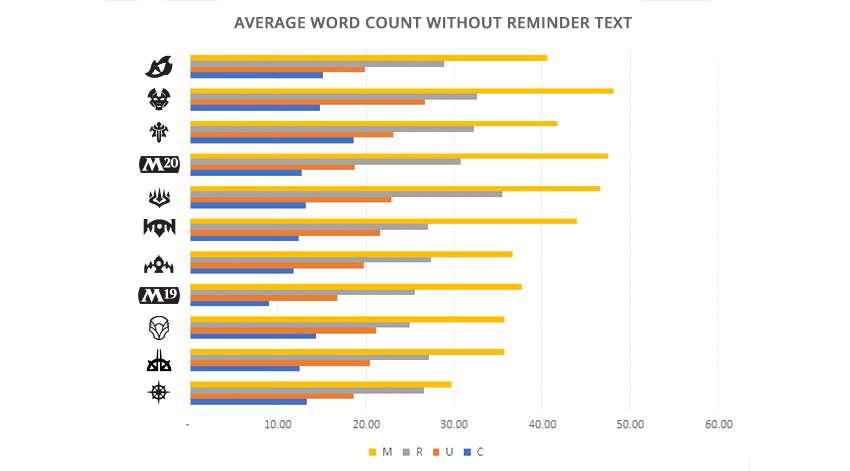
Well, well, well. Theros Beyond Death was poised to break records! That set was a ripe plum. A fattened goose. An easy mark. It had more words than it knew what to do with.
The big red flashing light was that so many cards had so much text that Gregg had, with regularity, started referring to the font size 1/4 point smaller than the standard minimum font size as "Theros minimum." He was only semi-joking. That's
INTRODUCING THE BOSS: AARON FORSYTHE
The Boss Man didn't get to his lofty position by letting jackpot scores slip past him. He could sniff out prey like a cheetah downwind of a flatulent springbok. Aaron sized up Theros Beyond Death and realized it could be taken down easier than Christmas decorations on an igloo during a heat wave. He gathered together the usual suspects and gave us our marching orders:
In general, I don't want to be setting records for words on cards unless something structural about a set forces it. I don't think THB has such a structure, so we can cut words.
When cards are too wordy, they become hard to talk about and hard to internalize, even for experienced players, and they appear incredibly daunting to non-experienced players.
In general, I don't think words are the enemy, and "fun words" can make cards more enjoyable, but there is a tipping point, and I think we're over it here.
Oh, yeah. It was on. Righteous robbery. Beautiful burglary. Lovely larceny. But we weren't going to rush in half-cocked. We needed to take the lay of the land.
INTRODUCING THE MARKS
Target #1: Rares that are so wordy they've got verbs falling out of their pockets when they try to waddle into the red zone.
Boss Man says: "I'd like to shoot for only having three rares with over 60 words, and right now there are 6."
Oh, snap. Cutting the herd in half.
Target #2: Rares that aren't quite as rich as the first batch, but won't even notice if their pockets get picked.
Boss Man says: "After that, look at the next-most wordy batch, which are the rares with greater than 35 words. Make sure all those words are doing work. Some of these may not be worth the processing power they currently demand of the audience."
Target #3: Those fat-cat mythic rares.
Boss Man says: "Here's where we're really setting bad records—we have over 25% more words per mythic than Dominaria. This needs to come down as much as it can."
Who was the crack team of word thieves the Boss Man assembled for this logo-logical caper? You've already met Gregg. The rest were
INTRODUCING THE FUTURIST: IAN DUKE
Ian was in charge of the Future Future League for Theros Beyond Death. He knew which marks to dodge and which to go after.
INTRODUCING THE CONSTRUCTION SPECIALIST: ANDREW BROWN
Andrew was the play designer assigned to Theros Beyond Death design. He was skilled at demolitions (blasting a card out of existence) and rebuilding (creating a new card from scratch).
INTRODUCING THE EVERYMAN HERO WHO'S IN OVER HIS HEAD BUT HAS THE SCRAPPY DETERMINATION TO GET THE JOB DONE JUST WHEN THINGS LOOK THE BLEAKEST: ME
I'm just your standard point-of-view character. I was in for one last job. I was also the lead designer of the whole danged set. So, how did we get here?
INTROSPECTIVE FLASHBACK
It's easy to say I wasn't paying attention. It's easy to say I had a blind spot. In truth, though I had led a number of design teams before, I'd never led the end of set design for a Standard-legal booster set. I've always led early design phases. So maybe this was something that other designers are watching out for or are naturally attuned to. I also have a high tolerance for wordiness and complexity. Each individual rare and mythic rare was charming, or telling a top-down mythological story, or was precisely engineered to do a job in Standard, or had a ton of words because it was a planeswalker or a Saga. Each one could be justified in a vacuum. It was only when they were collectively assessed during a review meeting for the rares and mythic rares that it became clear these gluttonous cards were gorging on words. When seemingly every rare in the set is pushing the minimum font size, we're in Ice Age territory.
And that's cold.
THE TARGET
Boss Man says: "If we can get the average rare word count down between 1.5–2 words per rare, that will be a victory."
OK. We had a goal. We knew what it'd take to make this score a success.
Note that this is all relative. The needs of any given set will dictate what looks good and feels good. A set with Sagas, Gods, titans, and planeswalkers is probably going to be wordier than its neighboring sets. Aaron didn't set an absolute number on word count, for this set or for any set. But he astutely assessed that our text boxes felt too bloated, and we could line our pockets with the lexicographic leftovers.
The setup was over. Now it was time for
WORDHEIST!
I know what you're thinking. You're thinking this is a heist like Ocean's Eleven. It's not. That's crazy. This is real-world problem solving, and that was a contrived Hollywood movie.
Please.
This is a heist like Ocean's Thirteen.
In that movie, the gang wanted to sink the grand opening of their enemy's casino. They accomplish this not with one grand plan, but with lots of simultaneous, narrow-focused little plans. They use loaded dice at the craps tables and loaded balls at the roulette tables. They use a backdoor program to usurp the slot machines. They use rigged card shufflers at the blackjack tables.
As a word thief, it is my job—nay, my sacred duty—to steal things. Including the plot of that movie. We set about using every trick in the book to siphon off words.
TACTIC: THE LEONARD SHELBY
This one is simple. It's also cheating. But if you expect a crack team of word thieves to behave honorably, I'd like to browse your personal library, if you know what I mean. (What I mean is that I would steal your words because thieves have no honor. "Honor among thieves" is a myth propagated by dishonorable thieves who would very much appreciate it if you would adhere to a rigid moral code that we can exploit, thank you very much.)
Anyway, this tactic is to judiciously cut reminder text from high-rarity cards. If a rare or mythic rare has room for reminder text, we include it. But if including a mechanic's reminder text would drop the card's text below the minimum font size, we pop that trap door and poof—it's gone. We can get away with this if there are enough commons and uncommons that contain reminder text to teach players what those keywords mean.
This'll come up again later.
TACTIC: THE TAHANI AL-JAMIL
Cards typically refer to themselves by their full titles. The first words of Ill-Gotten Gains aren't "Exile this spell." It's "Exile Ill-Gotten Gains." I don't know why that card popped into my head just now.
We've been making exceptions for second references on legendary creatures that have a lot of text and have names of the form "Name, Appellation." Look, for example, at Grimgrin, Corpse-Born. Its first ability references itself as "Grimgrin, Corpse-Born." But its second ability references itself as just "Grimgrin," and its third ability does that twice more. This wasn't universally true; Niv-Mizzet, Dracogenius (which was printed later than Grimgrin) refers to itself twice by its full name because it had room to do so.
Every single Throne of Eldraine legend that could drop their appellations on subsequent reference did so, regardless of text length. (That's Syr Carah, the Bold; Syr Elenora, the Discerning; Syr Faren, the Hengehammer; Yorvo, Lord of Garenbrig; and Korvold, Fae-Cursed King.)
Theros Beyond Death takes this to the next level. Fully half of its legendary creatures refer to themselves solely by their first names—even on initial reference. Of the 30 legendary creatures in the set, 15 of them shave off words using this tactic, including all Gods, Demigods, and titans. Five other legendary creatures still refer to themselves by their full names, and the other ten don't refer to themselves in their abilities. This is a tactic that will continue in future sets, when it's deemed appropriate.
TACTIC: THE ELDON TYRELL
This was both the simplest and the hardest to execute. In multiple cases, we outright killed card designs and created new designs to take their place.
For example, the set contains a blue-red legendary creature named Dalakos. This was a top-down design based on the Daedalus character from Greek mythology, and the card was intended for a Commander audience. And it was ridiculous. It was a soup of 66 fiddly, process-intensive words that was trying to inspire a Commander deck that doesn't currently exist. I liked that we were playing in novel space, but at some point, we were experimenting with templating the card using a two-column bulleted list in the middle of a paragraph. This design is now resting comfortably in a shallow grave behind the Chihuly Glass Garden.
To replace it, we put out a call for new designs that met the following parameters:
- Still a blue-red legendary creature
- Still a top-down design based on the Daedalus character from Greek mythology
- Still intended for a Commander audience, trying to inspire a Commander deck that doesn't currently exist
- About 20 words long
Ari Nieh, winner of the Great Designer Search 3, nailed it; his design is the one you'll see in boosters.
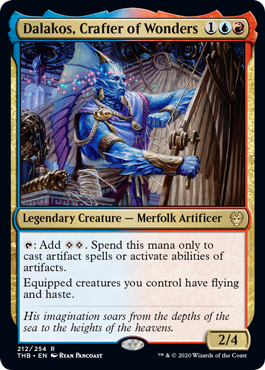
Other cards went through a similar process. Notably, we didn't redesign wordy cards that were working. If a card was some combination of fun, popular, novel, and powerful, we weren't gunning for it. But the stragglers that the play designers saw no use for, and the more casual players didn't find appealing either, got picked off. We replaced a few cards this way with simpler designs that met the same goals as the cards they supplanted.
TACTIC: THE VIDAL SASSOON
Some cards didn't need wholesale replacing, but instead just needed a bit of a trim. We scrutinized each card, asking whether all the words it was using were worth it.
The Akroan War, a Saga, got a shorter final ability.
Klothys, the new red-green God, got her primary ability streamlined.
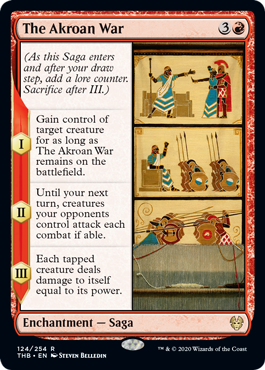

Dream Trawler got an ability lopped off, leaving it with a mere four (!) abilities. (You'll see this one tomorrow from AllieStrasza)
Calix, a new planeswalker, lost his fourth ability. This was a cool static ability that was fun to read and let you put extra loyalty counters on him in a nontraditional way—but if the choices were "we can't even print this card because the text doesn't fit" and "we can print this card with its three other abilities and adjust its numbers to compensate for the couple of loyalty counters per game it'll no longer receive," the choice was easy. (You can see Calix today over on TCGplayer.)
TACTIC: THE BILLY BEANE
This was my favorite one. One of the wordiest cards in the set was the rare legendary creature Polukranos, Unchained. Or, as it was affectionately known during design, Zombie Polukranos. I designed this card. I loved this card. It was very difficult to balance (lots of numbers, lots of moving pieces), so it evolved over the course of months, but the Play Design team had finally gotten it to a place where it felt correct and they also really enjoyed it. And now all its heads were on the chopping block because it had even more words than necks. How could we reduce the average word count of the Theros Beyond Death rares while keeping this card in the set?
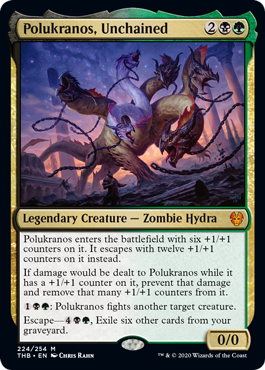
Easy—we swapped it up to mythic rare!
This wasn't capricious. The original Polukranos, World Eater was a mythic rare, and this card is entirely justified occupying the same spot. The only reason it was hanging out at rare was because mythic rare was crowded with Gods, planeswalkers, and titans, and moving this multicolored card into that group would upset the color balance slightly. But there had been calls to move it to mythic rare for months, because it always felt like it belonged there. This was just the final push I needed to pull the ol' switcheroo. Of course, the card that became rare to take its place had significantly fewer words.
TACTIC: THE GRETA GARBO
There were plenty of cards that we left alone. We scrutinized and discussed everything. For any given card, if there wasn't a positive change to be made in the words versus complexity versus fun matrix, we didn't make one. Some of the wordier cards that inspired the most conversation included Woe Strider; Atris, Oracle of Half-Truths; Enigmatic Incarnation; and Underworld Breach. In each case, we couldn't find a way to make the card both shorter and better. So we didn't.
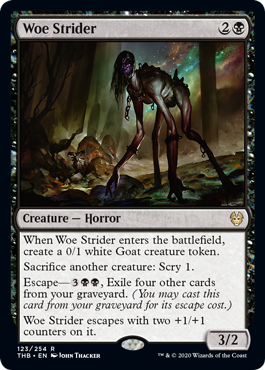
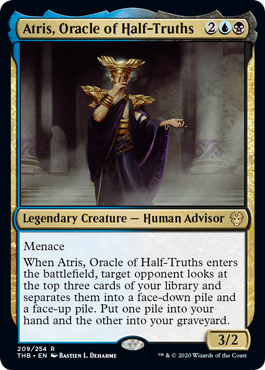
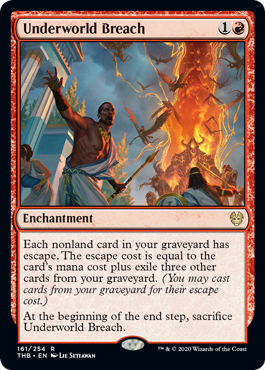
A BRIEF THEOLOGICAL ASIDE
Boss Man says: "On the Gods in particular
It takes a healthy sense of self-worth to go around stealing from Gods. But I was up to the challenge
I'm going to take this as a literal question, not a rhetorical one, because it makes me wonder why. How did we get here with these Gods?
The glib answer (with at least some kernel of truth to it) is that the Theros Gods took all the easy abilities already, so all we're left with are longer ones.
Our development process is at least somewhat different now, and for Heliod, Nylea, and Thassa, there are entire FFL decks built around them by Play Design, so they have highly engineered abilities (and Nylea and Thassa have procedural card-advantage abilities that involve zone changes).
I think a prime factor, though, is that the cause-and-effect is reversed. In Theros, devotion was a brand-new ability, so I believe we took pains to preserve devotion reminder text. The Theros Gods had room for reminder text because reminder text was considered mandatory, so the abilities were constrained accordingly (and then Purphoros wound up as an exception). By Born of the Gods, devotion reminder text on the Gods was already considered a luxury, and none of them had it. For Theros Beyond Death, I never even considered leaving room for reminder text on the Gods.
THE FINAL TALLY
We took a multifaceted approach to solving a practical problem, applying every design resource and problem-solving technique at our disposal. We were thoughtful and judicious—the goal of our entire team, from Aaron on down, was to make the best set possible, not the least wordy set possible. The directive was that wherever we could make the set better by reducing words, we should.
The goal was to get the average rare word count down between 1.5–2 words per rare.
Our final rare word count average (with reminder text) = 32.415
Our final mythic rare word count average (with reminder text) = 51
Our final as-fan word count (2R + M)/3 = 38.61
That was a reduction of 3.5 words per rare, 2.13 words per mythic rare, and 3.05 words per as-fan rare and mythic rare.
J-A-C-K-P-O-T!
The sweet, sweet sound of success. Cue up Claire de Lune for a final fountain montage. (I know, I know, that's back to Ocean's Eleven, not Ocean's Thirteen. What can I say—it has a better ending.)
INTRODUCING THE FEMME FATALE: THASSA'S ORACLE
But there's one more chapter. The ultimate Greta Garbo. The one that got away. The one I fell for. The one I protected. Was she as innocent as she appeared? Did she, in fact, play me this whole time? I'm happier not knowing.
This is a card named Thassa's Oracle. The wordiest card in the entire set. Let me introduce you.
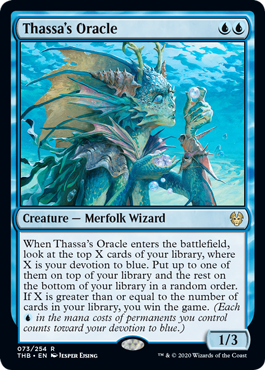
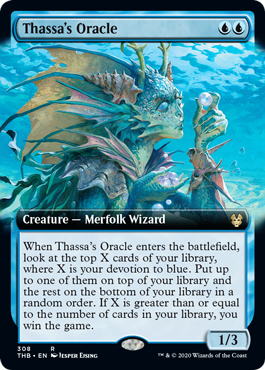
For a while, this card had just its first two sentences of rules text. It was powerful, but continually underwhelming. It just didn't feel rare, and multiple designers said so. So I added sentence number three—the one that maybe, sometimes, outright wins you the game. Now it had cachet. Now it turned heads. No one kicked Thassa's Oracle out of their fancy club anymore—but now it had a target on its back.
In his initial call to action regarding wordiness, Aaron mentioned a handful of cards by name. This was one of them.
Boss Man says: "Thassa's Oracle—the most egregious rare. Has almost twice as many words as most normal rares. I assume it's still tournament viable without the alt-win, and this might not be the right place to add that kind of stuff."
Ian agreed with Aaron. He supported taking the alternate-win condition off the card, feeling that it'd still be a plausible rare without that ability. Andrew Brown and I supported the status quo. The alt-win gave the card (and the set!) a certain je ne sais quoi that we were reluctant to lose. We looked at different deck-manipulation procedures, but the ones that were easier to read were harder to perform. In both cases, the extra words were worth it. I also looked into dropping the reminder text, but since the reminder text could fit, we were supposed to keep it. Ultimately, we saved enough words on other cards that this one swam right through.
You know how at the end of Ocean's Eleven, it turns out the heist wasn't really about the money after all—it was about the Julia Roberts character? Thassa's Oracle is our Julia Roberts. And that whole Ocean's Thirteen thing was a huge misdirect.
And that's how this story ends. The upshot is that, by no less an authority than Boss Man Aaron Forsythe, today's preview card is "The Most Egregious Rare." It's nice to be notorious.
Enjoy the set!
—Mark Gottlieb
